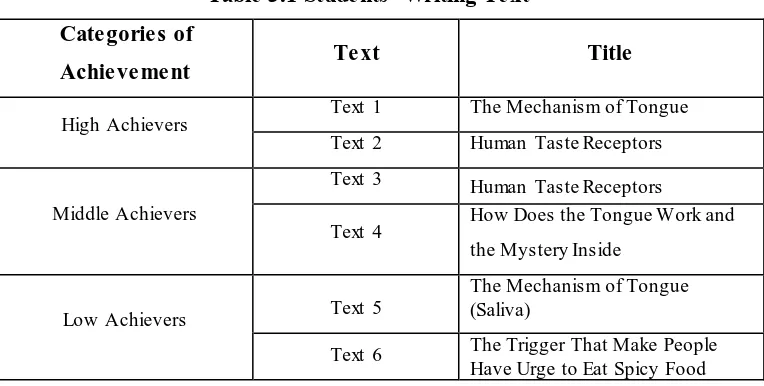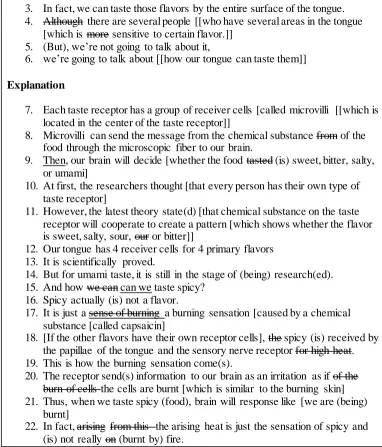CHAPTER III
RESEARCH METHODOLOGY
The previous chapter has covered the background theories for this study: Systemic
Functional Linguistics (SFL), Transitivity System, and Genre in Science. This
chapter focuses on the research design, site and participants, data collection, and
data analysis. The research design elaborates the method employed by this study,
its principles and characteristics. The site and participants discuss the place where
this study was conducted and the participant involved in this study. Data
collection explains the technique used in collecting the data. Data analysis
presents the procedure of Students’ Text Types and the identification of the texts’ features as proposed by Martin & Rose (2007), Anderson & Anderson (1997),
Knapp & Watkins (2005), Fang (2005), as well as Transitivity System
identification and classification as suggested by Halliday (1994), and Eggins
(2004).
3.1 Research Design
This study used descriptive qualitative research to answer the research questions.
This study is aimed to analyze, describe, categorize the data which involves an
investigation of some aspects in students’ writing text, such as the schematic structure and linguistic features. This study also investigated the difficulties
encountered by students in the process of writing their text. In the end, the
researcher made an interpretation of the findings, and drew a conclusion based on
the findings.
In association with qualitative design, this study is considered as a case
study since it used a text analysis (Creswell, 2012). Moreover, this study
attempted to describe and interpret a particular phenomenon (Marshall and
understanding of a certain topic through analyzing the Transitivity system in their
writing text.
3.2 Research Site
3.2.1 Setting
This study was conducted at International Program on Science Education
(later abbreviated as IPSE) Department in a state University in Bandung. IPSE is
the only department in Faculty of Science Education which uses English as the
instructional language. The course was English for Academic 2 which was
designed to enhance student competency in academic writing and academic
reading. The techniques used in that course were assignment, project, discussion,
and presentation. The media used in teaching learning process were audio visual
aids. In choosing the site, researcher considered some aspects such as time, cost,
and geographic condition.
3.2.2 Participant
The participants in this study were six students from second semester
majoring International Program on Science Education. They were chosen because
they were aimed to master science and English as the instructional language
throughout their study. They are prepared to teach science in international
secondary school. Thus, they use English most of the time at campus.
The six participants were chosen based on their average score during the
first meeting of their course until the mid-term. They were classified into three
different groups based on their score. The groups are: high achiever s, middle
achievers, and low achievers. According to Duff (2008), classifying the
participants would make the analysis a lot easier, especially in obtaining useful
3.3 Data Collection
3.3.1 Collecting Students’ Writing Text
In this study, the data were collected from a document collection and
interviews. The documents used in this study are the texts written by students who
are categorized into three groups: high, middle, and low achievers. The texts are
the result from their last stage of writing activity in their English for Academic
Purposes (EAP) class. The stages conducted in this study are elaborated as
follows.
In the first stage, the students were asked to read scientific data from some
articles, tables, and graph. Then, they were asked to write t heir interpretation of
the data as a summary which could show what they understood about the
presented data. After that, the teacher gave some feedbacks for each of their work.
In the second stage, students were given a text about animals’ taste receptor. They were asked to write a summary from that text. Further, they
learned some insights given by their teacher regarding the core framework of
science writing.
In the fourth stage, they worked in a group to discuss a topic related to the
text written in the previous stage. With their group, they were asked to write their
ideas. Then, they gave comment on each group’s work. The teacher also gave feedback too. Finally they revised their work based on the feedbacks gathered.
In the final stage, students were asked to re-write their group work with
the same topic individually. Then, they had to submit their writing to their teacher
to get feedback. The following table presents the title chosen by each category of
Table 3.1 Students’ Writing Text
Categories of
Achievement Text Title
High Achievers
Text 1 The Mechanism of Tongue
Text 2 Human Taste Receptors
Middle Achievers
Text 3 Human Taste Receptors
Text 4 How Does the Tongue Work and
the Mystery Inside
Low Achievers Text 5
The Mechanism of Tongue (Saliva)
Text 6 The Trigger That Make People
Have Urge to Eat Spicy Food
These categories helped researcher to analyze the students’ academic writing texts more easily. Each category gave deeper information about the text.
3.3.2 Interview
To clarify some data, conducting a recorded interview with the participants
is needed. According to Creswell (2002, 2014) there are some advantages of
conducting an interview during the process of data co llection in qualitative study.
The advantages are: interview is useful when participants are unable to be directly
observed, participants can provide historical information, an interview allows
researcher to control over the line of questioning, and it permits participant to tell
the detail of their personal information. The initial intention of using interview is
to get additional insight about the participants’ difficulties in writing the text from
their point of view.
3.4 Data Analysis
The data collected from this study were analyzed into three stages:
identification of the transitivity system that occurs in the texts, identification of
the type of the texts, and identification of schematic structure and the linguistic
3.4.1 Identification of Transitivity System
In order to identify the type of the students’ writing texts, the identification of transitivity system in each text was needed. Therefore, the students’ texts were broken down into number of clauses. The analysis of the Transitivity System was
based on the theory from Halliday and Matthiesen (2004), Eggins (2004), and
Emilia (2014). Table 3.2 is the example of transitivity identification from Text 3:
Table 3.2 Analysis of Transitivity System
3.4.2 Identification of Text Types
After identifying the participants and process that mostly occur in each of
students’ text, researcher determined the type of the text. This stage used Martin and Rose’s (2007), Anderson and Anderson’s (1997), and Knapp and Watkins’s (2005) theory about text types. The texts were categorized by the text types that
mostly occur in science such as Explanation Text, Report Text, and Procedure
Text.
3.4.3 Identification of Text’s Schematic Structure and Linguistic Features
To find out the extent to which students’ texts fulfill any type of text’s
schematic structure, the identification of each text’s schematic structure should be
conducted. The students’ texts were analyzed whether they consist of generic structure of certain text which occurs mostly in science field. Table 3.3 is the
example of schematic structure’s identification from Text 1 which is identified as
1. Human can taste many kinds of foods and drinks.
Senser Process:
Perceiving
Phenomenon
2. The human tongue has role in the process of speaking Processor Process:
possession
Table 3.3 Schematic Structure of Text 1
THE MECHANISM OF TONGUE Phenomenon
1. Tongue is one of our senses beside eyes, ears, nose, and skin.
2. Tongue can help us to taste different flavors; like sweet, salty, sour, biter, and umami.
3. In fact, we can taste those flavors by the entire surface of the tongue. 4. Although there are several people [[who have several areas in the tongue
[which is more sensitive to certain flavor.]] 5. (But), we’re not going to talk about it,
6. we’re going to talk about [[how our tongue can taste them]]
Explanation
7. Each taste receptor has a group of receiver cells [called microvilli [[which is located in the center of the taste receptor]]
8. Microvilli can send the message from the chemical substance from of the food through the microscopic fiber to our brain.
9. Then, our brain will decide [whether the food tasted (is) sweet, bitter, salty, or umami]
10. At first, the researchers thought [that every person has their own type of taste receptor]
11. However, the latest theory state(d) [that chemical substance on the taste receptor will cooperate to create a pattern [which shows whether the flavor is sweet, salty, sour, our or bitter]]
12. Our tongue has 4 receiver cells for 4 primary flavors 13. It is scientifically proved.
14. But for umami taste, it is still in the stage of (being) research(ed). 15. And how we can can we taste spicy?
16. Spicy actually (is) not a flavor.
17. It is just a sense of burning a burning sensation [caused by a chemical substance [called capsaicin]
18. [If the other flavors have their own receptor cells], the spicy (is) received by the papillae of the tongue and the sensory nerve receptor for high heat. 19. This is how the burning sensation come(s).
20. The receptor send(s) information to our brain as an irritation as if of the burn of cells the cells are burnt [which is similar to the burning skin] 21. Thus, when we taste spicy (food), brain will response like [we are (being)
burnt]
22. In fact, arising from this the arising heat is just the sensation of spicy and (is) not really on (burnt by) fire.
After analyzing each text’s schematic structure, the next step was
analyzing the features found in the text, which indicates to what extent students
text suggested by Halliday and Martin (1993), Martin and Veel (1998), and Fang
(2005; 2006).
3.4.4 Transcribing and Condensing Interview
The next step after analyzing students’ writing texts is identifying students’ difficulties in writing academic texts from interviews. First, the researcher
recorded and transcribed the interview. After that, the researcher classified the
students’ difficulties found in the interview based on the ones who encounter them.
Lastly, the researcher presented the data into a condensed body of information and
did the interpretation of the findings.
3.5 Concluding Remark
This chapter has presented the methodology used in this study which
includes research design, site and participant, data collection, and data analysis.
The research design of this study is a case-study. The texts were collected from
the second-year International Program on Science Education (IPSE) students in a
state university in Bandung. The text later were analyzed with Transitivity System
in Systemic Functional Linguistics suggested by Halliday and Matthiesen (2004),
Eggins (2004), and Emilia (2014), Scientific Texts Features suggested by Fang
(2005; 2006), and the Type of Texts in Science field proposed by Martin & Rose
(2007) and Knapp & Watkins (2005). The next chapter will elaborate the findings


